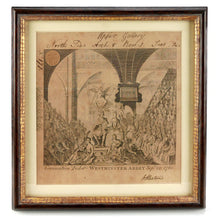Coronation of George III - Westminster Abbey Admission Ticket, 1761
Adding product to your cart
Overall: 34.5cm (13.5in) x 33cm (13in)
Line engraving on paper. Official ticket to the Coronation of George III in Westminster Abbey, dated ‘Sep'br 22 1761’ and numbered ‘No. 177’ in ink, with further manuscript seating instructions 'Upper Gallery / North Side Arch 8, Row 1, Seat 2’. Signed lower right ‘J. Heaton’ and bearing clear seal of the Dean and Chapter of the Abbey upper left. Engraved by George Bickham.
The engraved scene depicts King George and Queen Charlotte seated in the Abbey, heralded by angels and flanked by peers and peeresses wearing robes and coronets, in the foreground allegorical figures of Liberty holding the Magna Carta, Britannia holding her trident, and the Arts and Sciences. all beneath an entablature bearing the letters SPQB ‘Senatus Populas Que Britannorum’ (Senate and People of Britannia) in imitation of the emblematic phrase referring to the government of the Roman Republic.
Read more
Westminster Abbey was transformed for the Coronation of George III with numerous wooden galleries for Members of Parliament, ambassadors and musicians, in the quire, while in the nave, three tiers of galleries for the public were built into the arcade. A ticket for a single front seat cost 10 guineas each, while a higher box of twelve seats cost 50 guineas. The coronation service itself was lengthy business. On the way to the Abbey, the Bishop of Rochester nearly dropped the crown he was carrying; fortunately it had been pinned to the cushion on which it sat. One spectator noted that the heralds made ‘numerous mistakes and stupidities’, another that ‘the whole was confusion, irregularity and disorder’. The King felt it inappropriate to take Communion wearing his crown, and asked the Archbishop if it should be removed, the Archbishop in turn asked the Dean of Westminster, but had to report that neither knew what the usual form was; the king removed his crown anyway.
At some point in the proceedings, a large jewel is reputed to have fallen from the crown, which was later said to have been an omen presaging American Independence. During the sermon, the congregation in the nave who were unable to hear it, began to eat, mainly cold meat and pies, and drink wine brought with them and given out by servants; the ensuing clatter of cutlery resulted in an outburst of laughter. When the Queen wanted to visit the ‘retiring-chamber’ which had been constructed for her use in St Edward's Chapel behind the high altar, she found it already occupied by the Prime Minister who was making use of the Queen's close stool. When the king complained to Effingham about these problems, he admitted that there had been ‘some neglect’, but that he would make sure that the next coronation would be better organized.






